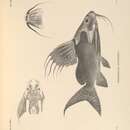Diagnostic Description
provided by Fishbase
Diagnosis: gill slits not extending ventrally beyond pectoral-fin insertions; eye large, its diameter 23-34.5% of head length and 48-75% of snout length; post-orbital length at least 60% of snout length; maxillary barbels unbranched, longer than head, without tubercles and bordered by a rather broad basal membrane restricted to their anterior thirds; outer mandibular barbels with simple, thin and rather long ramifications; branches of inner mandibular barbels shorter, subdivided and tuberculate; mandibular teeth slender and moderately long, numbering 39-62 (62 in the holotype); denticulations of pectoral-fin spines weak on outer margin and well developed on inner margin; dorsal-fin spine smooth anteriorly, except for a few apical denticles; humeral process triangular and not keeled ventrally; adipose fin well developed and rather close to rayed dorsal fin; branched dorsal-fin rays as well as dorsal- and pectoral-fin spines prolonged into filaments; spots present on body and fins (Ref. 57223).Coloration: body more or less dark brown. Back, sides, head and fins with few isolated small spots; depending on individuals, spots on fins more or less aligned in series; maxillary barbels (including membranes) black; fin filaments darker than fins themselves (Ref. 57223).
Diseases and Parasites
provided by Fishbase
Railletnema Infection. Parasitic infestations (protozoa, worms, etc.)
Life Cycle
provided by Fishbase
Oviparous (Ref. 205). Distinct pairing during breeding (Ref. 205).
Morphology
provided by Fishbase
Dorsal spines (total): 1; Analspines: 0
Biology
provided by Fishbase
Maximum TL was recorded at 22.2 cm, max. SL at 22.2 cm (Ref. 57223). Occurs over a muddy bottom but may also be found over rocks. Feeds mainly on insect larvae but will also take algae (Ref. 6868). This is also an upside-down species (Ref. 4537). Oviparous (Ref. 205).
Importance
provided by Fishbase
fisheries: of no interest; aquarium: commercial
Featherfin squeaker: Brief Summary
provided by wikipedia EN
The featherfin squeaker (Synodontis eupterus) or featherfin synodontis is a species of Synodontis catfish. This species is found in the basins of the White Nile, Volta and Niger Rivers and the Chad Basin. Featherfin squeakers are called such due to their ability to make noises to communicate with one another and also for their high feather-like fin which is valued by many hobbyists. Wild specimens can grow to a length of 30.0 centimetres (11.8 in) SL.
- license
- cc-by-sa-3.0
- copyright
- Wikipedia authors and editors

